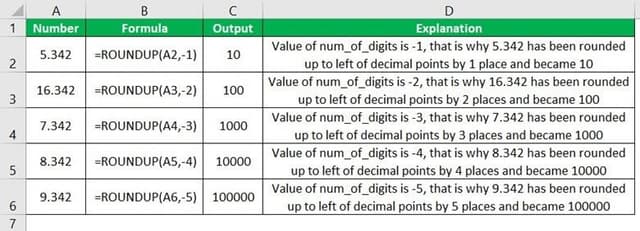Table Of Contents
What is ROUNDUP Excel?
The ROUNDUP excel function calculates the rounded value of the number to the upward side or the higher side. In other words, it rounds the number away from zero. Being an inbuilt function of Excel, it accepts two arguments–the “number” and the “num_of _digits.” For example, “=ROUNDUP(0.40,1)” returns 0.4.
Syntax
The syntax of the roundup excel formula is stated as follows:

The function accepts the following mandatory arguments:
- Number: This defines the floating-point number, which is to be rounded up.
- Num_of_digits: This defines the number of digits to which the number is to be rounded. It can be positive, negative or zero.
Note: Both the arguments of the ROUNDUP function must be integers.
The Values of “Num_of_Digits”
The “num_of_digits” argument can take the following values:
- If “num_of_digits” is greater than 0, the number is rounded up to the defined number of decimal places.
- If “num_of_digits” is equal to 0, the number is rounded up to the nearest integer.
- If “num_of_digits” is less than 0, the number is rounded up to the nearest 10, 100, 1000, and so on. All the decimal places are removed.
Note: The “num_of_digits” can take values from 1 to 9 only.
How to Use the ROUNDUP Function in Excel?
The ROUNDUP function works similar to the ROUND function, except that the former rounds the number upwards. Let us consider a few examples to understand the working of the ROUNDUP formula.
Example #1
Let us calculate the output with positive values of “num_of_digits.” This implies that the “num_of_digits” is greater than zero.

Example #2
Let us calculate the output with “num_of_digits” equal to zero.

Example #3
Let us calculate the output with negative values of “num_of_digits.” This implies that the “num_of_digits” is less than zero.


